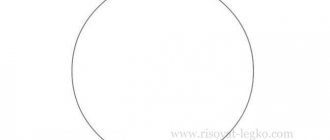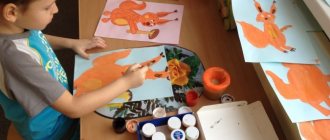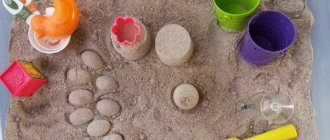Summary of educational activities for non-traditional drawing with children of the middle group
Municipal budgetary preschool educational institution kindergarten No. 9
Abstract
GCD for unconventional drawing
with middle school children
"Unusual colors"
Educator: Komarova E.B.
2019-2020 academic year
Educational areas:
artistic and aesthetic development and cognitive development
Item:
visual activity – drawing
GCD topic:
"Unusual colors"
Age group:
average 4-5 years
Target:
development of children's creative and cognitive abilities
Tasks:
Educational:
— To cultivate responsiveness, curiosity, interest in the fine arts;
Educational:
— Develop the ability to independently find a solution to a problem situation;
— Create a desire to decorate finished forms with a pattern;
— Maintain cognitive interest in the world around us;
— Develop creative abilities when drawing with cotton swabs;
Educational:
— Continue to expand children’s understanding of visual media; introduce a new technique of unconventional drawing with cotton swabs;
— Demonstrate experimentally the production of vegetable dye from beets;
— Fix the name of the color “burgundy”;
— To consolidate the concept of a pattern as repeating elements in drawing;
— Learn to evaluate finished work.
Methodical techniques:
-Techniques for motivating children’s activities: a surprise moment, a problematic situation;
— Techniques for activating children’s activities in the process of educational activities: conversation, use of TSO, asking riddles, explanations.
— Techniques for organizing children’s practical activities: defining and demonstrating how to make paint, productive activities (painting handkerchiefs).
— Techniques for maintaining interest in children: using TSO, alternating types of children’s activities, physical education break using audio recordings.
— Methods of assessment and self-assessment: encouragement, joint determination with the teacher and children of the quality of productive children’s activities.
Form of organization of children:
frontal, group
Technical support:
Screen, projector, presentation with riddles and variations of patterns on plates and handkerchiefs
Demonstration and handout material:
scraps of white fabric, cotton swabs, beets, a strainer, a teaspoon, jars of beet juice.
Expected Result:
- children will have a desire to help the animals, they will independently propose a solution to the problem situation: color the animals’ handkerchiefs;
— children will be interested in making vegetable paint;
- children will be able to independently invent and depict a pattern on handkerchiefs from elements familiar to them;
— children will have the opportunity to evaluate the finished work and show the pattern they like.
Summary of an open drawing lesson in the middle group “Teddy Bear”
MKDOU Selivanikha kindergarten
Summary of
an open drawing lesson in the middle group. Topic: “Teddy Bear”
Compiled by teacher: Tonkikh L.P.
2014 Lesson: Drawing.
Topic: "Teddy Bear". Goal:
1. Continue learning to master drawing examples (round and oval shapes), paint them in a circular motion, carefully, without going beyond the contour.
2. Be able to convey the characteristic features of an animal (bear), observing proportions. 3. Fix the shape, color, size. 4. Foster independence and accuracy in work. 5. Develop invention, creativity, fantasy. Materials:
Landscape paper (according to the number of children), paints, brushes, cups of water;
toy bear"; example of a teacher; group design: “Winter Glade”: Christmas trees, “drifts”; text of a story about a bear with musical accompaniment. Previous work:
Reading fairy tales, stories, memorizing poems, guessing riddles, looking at illustrations, learning games, etc.
Artistic word:
Making a riddle about a bear, a story about a bear.
Individual work:
With Vika, Valeria - teach children to convey the characteristic features of an animal.
Methodical techniques:
1. Conversation about animals (domestic and wild);
name them; why are they called that? 2. The teacher asks a riddle; 3. Guessing the answer by children; 4. Game technique; 5. Consolidation of shapes, colors, sizes; 6. The teacher demonstrates the technique of drawing and painting a bear figure with an explanation; 7. Independent work of children, accompanied by the story “About the Bear” with a teacher, using a musical soundtrack; 8. Analysis of children's works; 9. Dynamic pause (to music). Progress of the lesson.
Children enter the group room, paying attention to the guests.
Children greet guests and sit on chairs. I’m having a conversation about animals:
Q. – What animals do children know?
Name it. D. – Children’s answers. V. – What animals are these? D. – Children’s answers. V. – Why are they called that? D. – Children’s answers. V. – What animals do children still know? Please call me. D. – Children’s answers. V. – What kind of animals are these? Why are they called that? D. – Children’s answers. V. - Well done! Right! Gaming technique. I draw the children’s attention to the fact that someone is moving in the “snowdrift.”
Who's there?
I ask you to guess the riddle:
“Where does he live?
In the most often, the most real, there he walks, there he sleeps, there he raises his children. He loves pears, he loves honey, he is reputed to have a sweet tooth, but most of all he loves a deep, long sleep. He will lie down in the fall, and will rise only when spring comes. Who is this?" D. – Children’s answers. I pull out the bear cub and tell the children that he lost his mother, so he ended up in our forest clearing
.
Let's help him find her. I propose to draw a portrait of a bear cub and hang it throughout the forest.
But first tell me: V. – What color is the bear cub’s fur coat?
D. – Children’s answers. Q. – What shape does the head have? Torso? Legs? D. – Children’s answers. V. – How many legs does a bear have? D. – Children’s answers. The teacher demonstrates the technique of drawing and painting a bear figure.
Independent work.
To the accompaniment of music, the children begin to draw, and the teacher offers to simultaneously listen to a story that happened to one bear. Children draw and listen. “Once on a frosty winter, a bear walked along the edge of the forest to his home in a warm fur coat. He walked towards his den along a country road and, walking across the bridge, stepped on the fox’s tail. The fox raised a cry, the dark forest rustled, and the bear, in fright, instantly climbed onto a large pine tree. On a pine tree, a cheerful woodpecker caulked a house for a squirrel and said: “You, bear, must watch your step!” From that time on, the bear decided that in winter he needed to sleep, not walk along the paths, and not step on tails. He sleeps serenely in a den in winter under a snowy roof. And it’s no accident that I’m glad that I was born without a tail.” Upon completion, I propose to hang up the work and do an analysis together with the teddy bear. In the analysis, note the correctness of the depiction of forms and shading. I invite the children to stand in a circle and do physical exercises to the music: “The bear and the doll are stomping briskly, They are stomping briskly, look! (Children stomp their feet) And they clap their hands loudly, They clap loudly: one, two, three! (Clap their hands) The bear is having fun, the bear is having fun, (They make “springs”) The bear turns his head. (Turns the head left and right) The doll is having fun, it’s also fun, (Hands on the belt, put your foot forward on the heel) It’s also fun oh-oh-oh!






